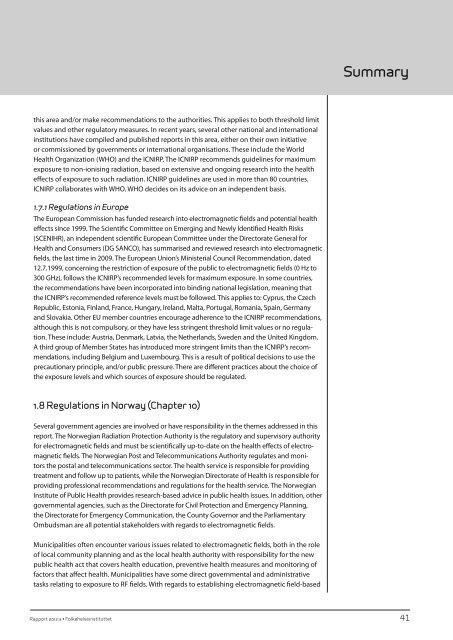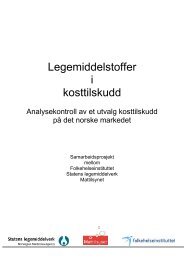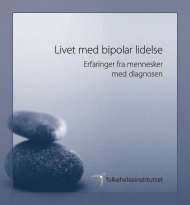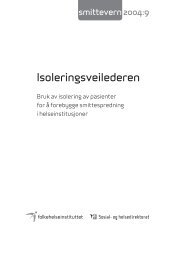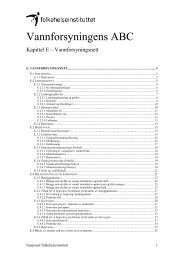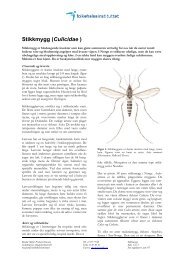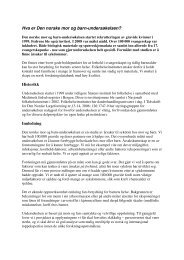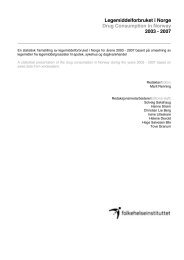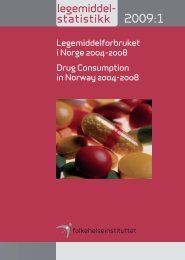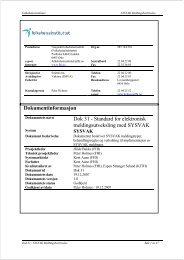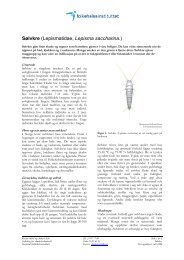rapport 2012:3 - Nasjonalt folkehelseinstitutt
rapport 2012:3 - Nasjonalt folkehelseinstitutt
rapport 2012:3 - Nasjonalt folkehelseinstitutt
You also want an ePaper? Increase the reach of your titles
YUMPU automatically turns print PDFs into web optimized ePapers that Google loves.
this area and/or make recommendations to the authorities. This applies to both threshold limit<br />
values and other regulatory measures. In recent years, several other national and international<br />
institutions have compiled and published reports in this area, either on their own initiative<br />
or commissioned by governments or international organisations. These include the World<br />
Health Organization (WHO) and the ICNIRP. The ICNIRP recommends guidelines for maximum<br />
exposure to non-ionising radiation, based on extensive and ongoing research into the health<br />
effects of exposure to such radiation. ICNIRP guidelines are used in more than 80 countries.<br />
ICNIRP collaborates with WHO. WHO decides on its advice on an independent basis.<br />
1.7.1 Regulations in Europe<br />
The European Commission has funded research into electromagnetic fields and potential health<br />
effects since 1999. The Scientific Committee on Emerging and Newly Identified Health Risks<br />
(SCENIHR), an independent scientific European Committee under the Directorate General for<br />
Health and Consumers (DG SANCO), has summarised and reviewed research into electromagnetic<br />
fields, the last time in 2009. The European Union’s Ministerial Council Recommendation, dated<br />
12.7.1999, concerning the restriction of exposure of the public to electromagnetic fields (0 Hz to<br />
300 GHz), follows the ICNIRP’s recommended levels for maximum exposure. In some countries,<br />
the recommendations have been incorporated into binding national legislation, meaning that<br />
the ICNIRP’s recommended reference levels must be followed. This applies to: Cyprus, the Czech<br />
Republic, Estonia, Finland, France, Hungary, Ireland, Malta, Portugal, Romania, Spain, Germany<br />
and Slovakia. Other EU member countries encourage adherence to the ICNIRP recommendations,<br />
although this is not compulsory, or they have less stringent threshold limit values or no regulation.<br />
These include: Austria, Denmark, Latvia, the Netherlands, Sweden and the United Kingdom.<br />
A third group of Member States has introduced more stringent limits than the ICNIRP’s recommendations,<br />
including Belgium and Luxembourg. This is a result of political decisions to use the<br />
precautionary principle, and/or public pressure. There are different practices about the choice of<br />
the exposure levels and which sources of exposure should be regulated.<br />
1.8 Regulations in norway (Chapter 10)<br />
Several government agencies are involved or have responsibility in the themes addressed in this<br />
report. The Norwegian Radiation Protection Authority is the regulatory and supervisory authority<br />
for electromagnetic fields and must be scientifically up-to-date on the health effects of electromagnetic<br />
fields. The Norwegian Post and Telecommunications Authority regulates and monitors<br />
the postal and telecommunications sector. The health service is responsible for providing<br />
treatment and follow up to patients, while the Norwegian Directorate of Health is responsible for<br />
providing professional recommendations and regulations for the health service. The Norwegian<br />
Institute of Public Health provides research-based advice in public health issues. In addition, other<br />
governmental agencies, such as the Directorate for Civil Protection and Emergency Planning,<br />
the Directorate for Emergency Communication, the County Governor and the Parliamentary<br />
Ombudsman are all potential stakeholders with regards to electromagnetic fields.<br />
Municipalities often encounter various issues related to electromagnetic fields, both in the role<br />
of local community planning and as the local health authority with responsibility for the new<br />
public health act that covers health education, preventive health measures and monitoring of<br />
factors that affect health. Municipalities have some direct governmental and administrative<br />
tasks relating to exposure to RF fields. With regards to establishing electromagnetic field-based<br />
Summary<br />
Rapport <strong>2012</strong>:3 • Folkehelseinstituttet 41


